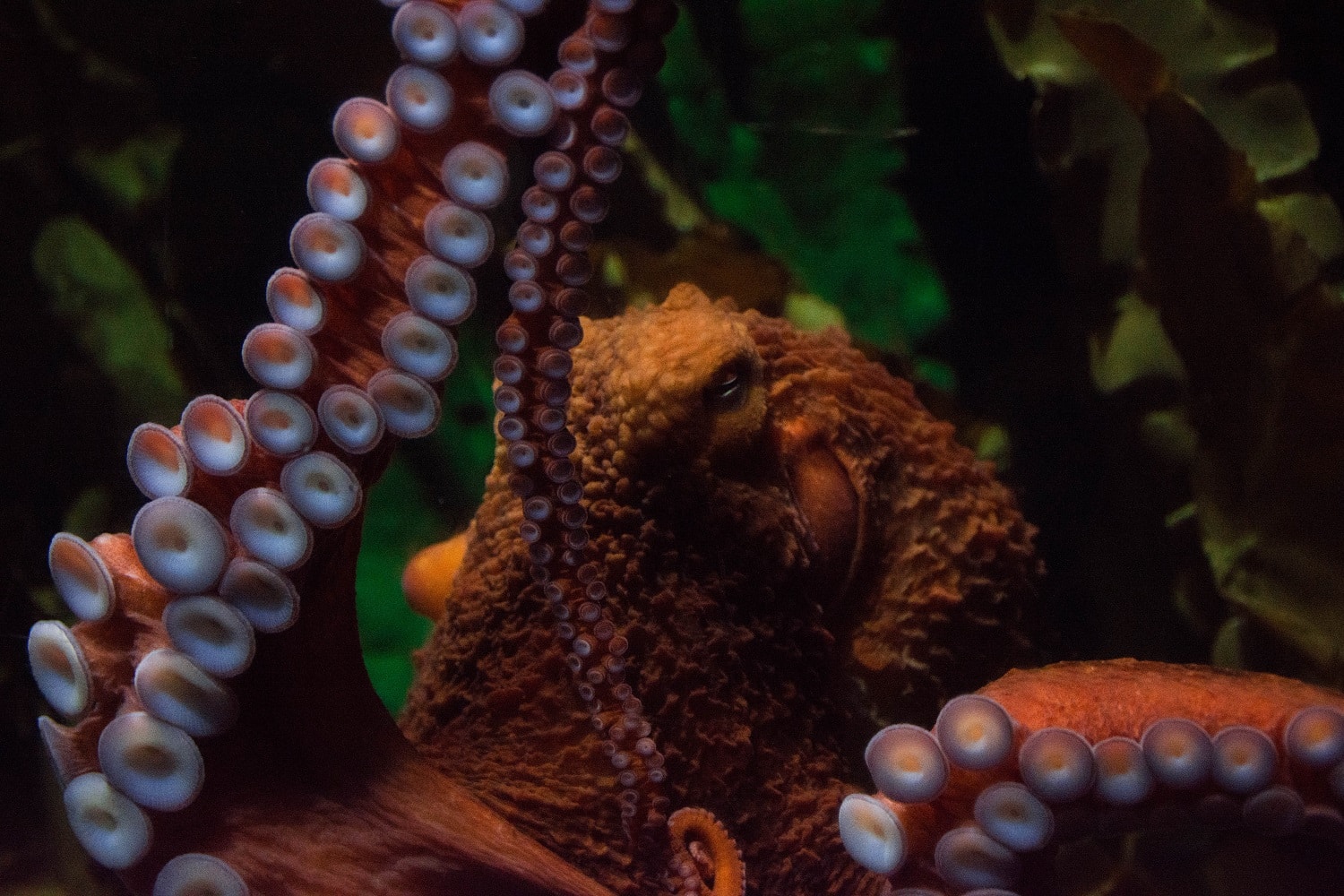Did you know?
True to its name – the giant pacific octopus is bigger than any other species of octopus, making them hard to miss and a real presence in our oceans. There’s plenty to learn about these speedy, colour-changing creatures, so let’s dive into everything you should know.
Species
What is a Giant Pacific Octopus?
The giant pacific octopus (Enteroctopus dofleini) is classified as a marine cephalopod, which comes from the Greek word for ‘head-foot’. Squid, cuttlefish and nautiluses are among some of the species also in the cephalopod order.
Appearance
What does a giant pacific octopus look like?
Picture a regular common octopus with its 8 legs and double it in size – that’s the main difference between the common and giant pacific octopus. Growing on average 10-16 feet, with the largest size ever recorded specimen 30ft, and weighing up to a whopping 110 pounds, we weren’t kidding when we said they’re hard to miss! Alongside their larger-than-life size, they also have longer average lifespans compared to any other species of octopus, often living up to 3-5 years old in the wild.
They’re normally a reddish-brown colour all over their bodies, except for their arms which tend to fade to a light pink or white shade where their suction cups can be found.
Their large heads contain two small plates, forming a protective shell. Giant pacific octopuses also have beaks, which they use to kill and eat their prey, alongside sometimes using it as a defence mechanism. These beaks can inject venom directly into their prey if they come close enough.
Habitat
Where do giant pacific octopus live?
Native throughout the Pacific Ocean, they inhabit the intertidal zone to depths of 2,000m. Preferring cold, oxygen-rich waters, the giant pacific octopus can be found in Bala California, all the way to Alaska, Russia, Japan and Korea!
Despite them being common, you’re unlikely to spot them in the wild because they tend to spend most of their time hiding in small spaces and crevices. The giant pacific octopus is also nocturnal, so they’re most active during the nighttime.
Factfile
1. They have excellent defence mechanisms
As with other species of octopus, this species can eject a cloud of toxic ink if they feel threatened, giving them time to propel themselves away. While this might be a well-known fact, what you might not know is that the ink can even be toxic to the giant pacific octopus itself if there’s a lack of water flow to clear it.
2. They have 3 hearts!
Did you know that all octopuses have 3 hearts? Well now you do! Two of their hearts pump blue blood across the gills, while one circulates blood around the body. If you’re wondering why their blood is blue rather than red, this is because it uses a copper-based protein called hemocyanin to carry oxygen around the octopus’ body.
3. The giant pacific octopus doesn’t have bones
As an invertebrate, this means that the giant pacific octopus has no bones in its body. In fact, they’re made up of 90% muscle, which helps them squeeze into tiny gaps and hide! The hardest part of their body is their beak, so as long as they can squeeze their beak through a gap, the rest of their body can follow. They are known as the Houdini’s of the animal kingdom!
4. Giant pacific octopuses are highly intelligent
That’s right – thanks to their excellent working memory, this octopus species along with others is known to be a clever creature. They show off their skills by solving puzzles and mazes, remembering routes, displaying emotions and personalities, and even playing with toys. Their memory also means they’ve been known to recognise individuals, including other octopus and human faces. This is one of the reasons that enrichment activities in captivity are so important to keep their brain active and provide a good quality of life.
5. Despite their large size, their diets consist of much smaller food
You might be shocked to find out that despite being such giants in the ocean, their main diet consists of smaller fish and invertebrates like lobsters and shrimp. They hide in smaller spaces to sneak up on their prey and can squeeze them using their muscular bodies.
See a giant pacific octopus at Blue Planet Aquarium!
Want to learn more about their habits and appearance? Visit our very own giant pacific octopus here at Blue Reef Aquarium, which you can find in our Rock Pools Exhibit mimicking the natural habitats of the species we have here. Check the daily schedule on the day of your visit to make sure you’re at one of our Octopus Talks from the experts!






